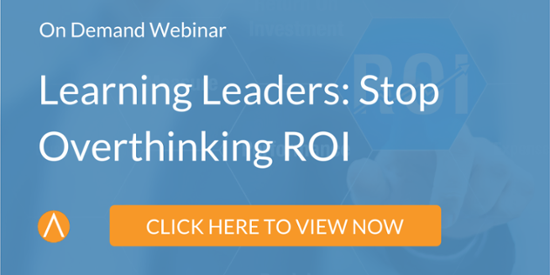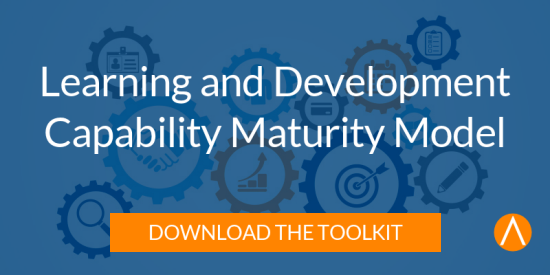Posted by Caveo Learning ● March 3, 2016
Help Your Learning Organization Find Its Direction
 Imagine a company that is pursuing a wrong strategy, or which lacks a strategy entirely. Shareholders, investors, employees, and other stakeholders would lose all confidence in the ability of that company to be successful.
Imagine a company that is pursuing a wrong strategy, or which lacks a strategy entirely. Shareholders, investors, employees, and other stakeholders would lose all confidence in the ability of that company to be successful.
And yet for so many learning organizations, that’s exactly the situation. According to research by Brandon Hall Group, only 57% of companies possess a learning strategy, and 96% of the companies that do have a learning strategy have trouble getting it right.
Why does L&D struggle so mightily with getting learning strategy right?
Most learning leaders understand that L&D exists to create business value, and that their funding and credibility are correlated with how much value they create for their organizations. Unfortunately, they often struggle to execute on their vision, missing key fundamental components they need for the learning function to be successful.
You Can’t Buy Metrics
Metrics and evaluation, including ROI, is a topic that receives a ton of attention in the learning & development industry, and for good reason. Most learning leaders realize they need metrics in place because key business stakeholders use them and demand them, but there is generally a failure to execute on them.
Here’s a dirty little secret: you can’t buy metrics. Software and tools help to enable them, but they aren’t a fix. Organizations invest many resources into that shiny new tool that’s going to provide them the metrics that they think matter, but in most cases, they wind up disappointed. They may even realize that those expensive tools are not giving them what they need, but they continue to use them to save face. The path to actionable metrics is not easy—it requires perseverance and transformation of the foundational element of the L&D function, which is the execution methods.
Think of your L&D organization like a car. If you want to know how fast your car is going, or how efficient it is at fuel consumption, you would look at the dashboard. However, if the engine needs repair, you have a flat tire, or you’re out of fuel, it doesn’t matter what the dashboard says—you’re not going anywhere. Do you buy a fancy new dashboard, or do you fix the problem? Metrics are crucial to identifying the problem, but they aren’t the problem.
L&D organizations can be viewed from this perspective as well. For an L&D organization to execute, it must be fully aligned with the business strategy, all the way down to the methods used to execute, and it must have the organizational capabilities and team competencies to be effective. If an L&D organization lacks expertise or capacity to deliver, it needs to team with external learning partners to fill those gaps.
When Caveo partners with CLOs and other heads of learning, we view their organizations through the L&D Compass. They need a learning strategy that aligns with the business strategy, and yet about half of L&D organizations are unable to clearly articulate their strategy. Learning leaders (incorrectly) think they have it figured out and are too proud to hire an expert. Big mistake. We all know that feedback is beneficial to challenge our thinking. Heads in other areas of the business—including the C suite—are hiring outside experts. Why shouldn’t L&D?
Check Your Maturity Level
Caveo has determined that there are seven fundamental competencies that L&D organizations must have to be successful. In assessing these seven competencies, we can evaluate the L&D organization’s overall maturity.
Why wouldn’t you want to know how good you are at something? L&D leaders who avoid this type of assessment are typically hiding a truth—they know they need improvement, but they can’t answer how much improvement is really needed and how they can incrementally measure that improvement. And more importantly: What’s the improvement plan? They don't know.
It’s no secret that people are the most valuable asset in any organization. L&D leaders often tell us that their team development plans are left up to some anonymous training association, or worse—simply sending people to conferences. We all know what happens at conferences and how effective most of those are for learning. This is a shotgun approach to team development.
In our experience, learning leaders are best served by taking a team approach to competency development, rather than the more resource-intensive and costly individual focus. Once a competency is developed, focus on the next one. For example, focus on project management skills for the entire team for a quarter, then change the focus to performance improvement in the subsequent quarter. This approach creates common language and meaning among team members, in addition to building camaraderie.
Execution. Execution. Execution.
A perfect learning strategy is useless if it’s not well executed. The L&D function is an end-to-end business process; business needs flow in, and effective learning and performance solutions should flow out. Just like any end-to-end process, documentation, roles and responsibilities, enabling technologies, and measurement are required. Having repeatable and standardized execution methods increase efficiency and effectiveness. (By the way, both efficiency and effectiveness can be measured, too.)
How many L&D organizations measure their functional throughputs and outputs? In our experience, not many—documentation rarely exists that details how the learning team executes and its common methods.
Despite all this pessimism, the good news is that learning leaders have the opportunity to consistently deliver measurable business value to the organizations they serve. Instead of procuring that new learning technology or reorganizing the learning function, look inward at your organization across the dimensions of strategy, capability, competency, and execution. Start with the right expertise and capacity, and you’ll be on your way to transforming L&D into a center of excellence that the business can confidently look to for support.
Topics: Learning Strategy



